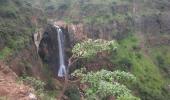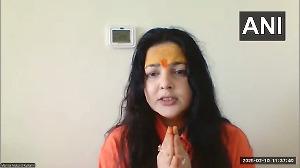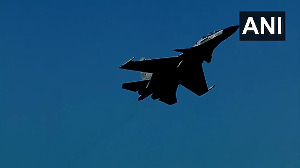Standing at the edge of Dholavira is witnessing history textbooks crammed in school coming to life.
One is suddenly standing face to face with a 4,000-year-old civilisational site that is now but a ruin.

It isn't easy to get to Dholavira. Located at one end of the country, the site is on Khadir Island in the Great Rann of Kutch in Gujarat.
One had to catch the overnight train from Ahmedabad to first get to Kutch. Not just that, one also had to wake up at an unearthly hour and drive for about two hours plus to make it to Dholavira before the site became scorchingly and unbearably hot.
I was too lazy for it all.
The whole itinerary threw me back to our childhood days when we would be awoken in the biting cold, at a godforsaken hour to catch the sun come up over Tiger Hill in Darjeeling.
And truth be told, I hadn't really heard too much about this place. But I gave in and joined our merry gang of six that had set their respective alarm clocks for 3 am for Dholavira.

No sooner that we hit the 30 km stretch, that has recently earned the sobriquet of 'road to heaven', that our bleary eyes started clearing up. The nickname seemed justified as one felt as if one had suddenly been inserted inside a postcard.
We found ourselves on a long, straight, unending sort of a single road, that was flanked on both sides by the saline white plains of Kutch with absolutely nothing else that met the eye.
Apparently, this very road gets jammed during the annual Rann Utsav but for now, there was nobody on it except us. No other vehicles. No people. And just the hint and glint of a faraway awakening horizon.
The vistas were stunning and bit by bit a soft, orange gradient began to envelop the skyline.
Maintaining the quiet, we got out of our cars for photos and caught a flamboyance of pink flamingos in flight. It was easily one of the best dawns one had ever caught. We were all awake and ready for Dholavira!

Standing at the edge of Dholavira is witnessing history textbooks crammed in school coming to life. One is suddenly standing face to face with a 4,000-year-old civilisational site that is now but a ruin.
Part of the ancient Harappan civilisation, this site was discovered in the mid-1960s and was declared a UNESCO World Heritage site in 2001.
Known for its well-preserved remains, the erstwhile city included a fortified castle, ceremonial grounds, as well as a funeral area and is thus considered to be one of the two more remarkable excavations of the Harappan or the Indus Valley Civilisation, the other being Lothal, also in Gujarat.

Locally called kotada or fort, at 100 hectares or so, the expanse of the site is sprawling. And really arid with not a single spot of shade to be seen.
A local guide, who joins us, gets talking. He explains that though the site was unearthed by the Archaeological Survey of India in the 1960s, it was only much later in the 1990s that the excavations, under archaeologist R S Bisht, revealed a well-planned and systematically laid-out city.
Excavations since then have thrown up a variety of artefacts including terracotta, beads, copper and gold ornaments, urns and other vessels, suggesting trade links that the Indus Valley had with lands as far off as Mesopotamia, which is in modern day Iraq.

A board guides us to what was once the Citadel. The planned city was apparently divided into three towns -- the Citadel, the Middle and the Lower Towns, with a large ceremonial ground located between the Citadel and the Middle Town.
We walk past each to reach the south of the Citadel, where huge water reservoirs lie. With sparse rainfall, water conservation must have been absolutely crucial in the desert, making water one of the most precious commodities.
The site of Dholavira is also where one the world's earliest water conservation systems have been found. Satellite photography depicts how the reservoirs also had a rainwater harvesting system even 4,000 years ago!
This civilisation also had well-laid out lanes and pathways and a efficiently-constructed underground drainage system for sanitation.

Standing quite literally at the edge of a civilisation was humbling to say the least. For all the tall claims we make about human strides of progress, ruins are cold, stark evidence to the ephemeral nature of even our most glorious chapters -- a civilisational post mortem up for public viewing and dissection. Yet, at the same time, they showcase the most amazing marches that humanity has had and the brilliant dimensions and distances it has traversed.
And just as the sun begins to shine on the age-old stones that have been quiet for an eternity, they seem to whisper to each of us standing mutely, go seize your day, for Time waits for no one.

Best time to visit
Between October to February. Summers are blisteringly hot.
Getting there
Reach Ahmedabad and then an overnight bus or train will get you to Kutch. And then there's a drive after that.
Pocket pinch and must buys
There's nothing to be picked up at Dholavira (though one wished there were good booklets or brochures with greater documentation and detail.) But Kutch is an absolute treasure trove of art and craft. Plenty of homestays and other hotel accommodations in Kutch.
Supriya Newar is a writer and poet from Calcutta. Besides being a music aficionado, she is also an avid traveller, particularly drawn to places that have a je ne sais quoi about them. She may be reached on
connect@supriyanewar.com. Her website is www.supriyanewar.com
Feature Presentation: Ashish Narsale/Rediff.com











 © 2025
© 2025